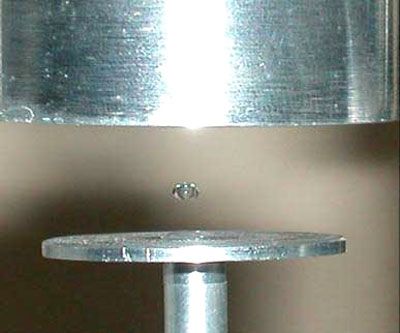Air, like all matter, consists of molecules. Even a tiny region of air contains vast numbers of air molecules. The molecules are in constant motion, traveling randomly and at great speed. They constantly collide with and rebound from one another and strike and rebound from objects that are in contact with the air.
When an object vibrates it produces sound waves in the air. For example, when the head of a drum is hit with a mallet, the drumhead vibrates and produces sound waves. The vibrating drumhead produces sound waves because it moves alternately outward and inward, pushing against, then moving away from, the air next to it. The air particles that strike the drumhead while it is moving outward rebound from it with more than their normal energy and speed, having received a push from the drumhead.
These faster-moving molecules move into the surrounding air. For a moment, the region next to the drumhead has a greater-than-normal concentration of air molecules — it becomes a region of compression. As the faster-moving molecules overtake the air molecules in the surrounding air, they collide with them and pass on their extra energy. The region of compression moves outward as the energy from the vibrating drumhead is transferred to groups of molecules farther and farther away.
Air molecules that strike the drumhead while it's moving inward rebound from it with less than their normal energy and speed. For a moment, the region next to the drumhead has fewer air molecules than normal — it becomes a region of rarefaction. Molecules colliding with these slower-moving molecules also rebound with less speed than normal, and the region of rarefaction travels outward.
The wave nature of sound becomes apparent when a graph is drawn to show the changes in the concentration of air molecules at some point as the alternating pulses of compression and rarefaction pass that point. The graph for a single pure tone, such as that produced by a vibrating tuning fork, would show a sine wave (illustrated here). The curve shows the changes in concentration. It begins, arbitrarily, at some time when the concentration is normal and a compression pulse is just arriving. The distance of each point on the curve from the horizontal axis indicates how much the concentration varies from normal.
Each compression and the following rarefaction make up one cycle. (A cycle can also be measured from any point on the curve to the next corresponding point.) The frequency of a sound is measured in cycles per second or hertz (abbreviated Hz). The amplitude is the greatest amount by which the concentration of air molecules varies from the normal.
The wavelength of a sound is the distance the disturbance travels during one cycle. It's related to the sound's speed and frequency by the formula speed/frequency = wavelength. This means that high-frequency sounds have short wavelengths and low-frequency sounds have long wavelengths. The human ear can detect sounds with frequencies as low as 20 Hz and as high as 20,000 Hz. In still air at room temperature, sounds with these frequencies have wavelengths of 75 feet (23 m) and 0.68 inch (1.7 cm) respectively.
Intensity refers to the amount of energy transmitted by the disturbance. It's proportional to the square of the amplitude. Intensity is measured in watts per square centimeter or in decibels (db). The decibel scale is defined as follows: An intensity of 10-16 watts per square centimeter equals 0 db. (Written out in decimal form, 10-16 appears as 0.0000000000000001.) Each tenfold increase in watts per square centimeter means an increase of 10 db. Thus, an intensity of 10-15 watts per square centimeter can also be expressed as 10 db and an intensity of 10-4 (or 0.0001) watts per square centimeter as 120 db.
The intensity of sound drops rapidly with increasing distance from the source. For a small sound source radiating energy uniformly in all directions, intensity varies inversely with the square of the distance from the source. That is, at a distance of two feet from the source the intensity is one-fourth as great as it is at a distance of one foot; at three feet it is only one-ninth as great as at one foot, etc.
Pitch
Pitch depends on the frequency; in general, a rise in frequency causes a sensation of rising pitch. The ability to distinguish between two sounds that are close in frequency, however, decreases in the upper and lower parts of the audible frequency range. There is also variation from person to person in the ability to distinguish between two sounds of very nearly the same frequency. Some trained musicians can detect differences in frequency as small as 1 or 2 Hz.
Because of how the hearing mechanism functions, the perception of pitch is also affected by intensity. Thus, when a tuning fork vibrating at 440 Hz (the frequency of A above middle C on the piano) is brought closer to the ear, a slightly lower tone, as though the fork were vibrating more slowly, is heard.
When the source of a sound is moving at a relatively high speed, a stationary listener hears a sound higher in pitch when the source is moving toward him or her and a sound lower in pitch when the source is moving away. This phenomenon, known as the Doppler effect, is due to the wave nature of sound.
Loudness
In general, an increase in intensity will cause a sensation of increased loudness. But loudness does not increase in direct proportion to intensity. A sound of 50 dB has ten times the intensity of a sound of 40 dB but is only twice as loud. Loudness doubles with each increase of 10 dB in intensity.
Loudness is also affected by frequency because the human ear is more sensitive to some frequencies than to others. The threshold of hearing — the lowest sound intensity that will produce the sensation of hearing for most people — is about 0 dB in the 2,000 to 5,000 Hz frequency range. For frequencies below and above this range, sounds must have greater intensity to be heard. Thus, for example, a sound of 100 Hz is barely audible at 30 dB; a sound of 10,000 Hz is barely audible at 20 dB. At 120 to 140 dB, most people experience physical discomfort or actual pain, and this level of intensity is referred to as the threshold of pain.


